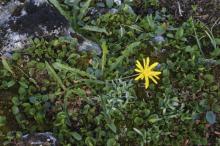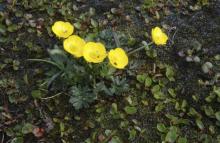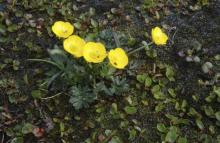A one day walk from the railway station Finse to Geiteryggen crossing a ridge at about 1600m altitude. We arrived by train in the evening, spent the night at the cabin there ( http://finsehytta.turistforeningen.no/cabin.php?ca_id=31&fo_id=5362&lang=eng ) and started walking early next morning arriving at Geiteryggen ( http://geiterygghytta.turistforeningen.no/cabin.php?ca_id=35&fo_id=5219&lang=eng ) where we had our cars some hours later.
Finse and Finsevatn with sløke, Angelica archangelica in the foreground.
The summer has been very warm but it is still a lot of snow in this area. A lot of snow means a lot of water!
Comments
Very impressive, Trond!
Very impressive, Trond!
Rocks and snow.
Rocks and snow. Cassiope hypnoides Cardamine bellidifolia
Some Saxes. Saxifraga cespitosa oppositifolia rivularis
stellaris tenuis Not a Sax but a nice lichen Solorina tenuis
Bartsia alpina
Bartsia alpina Cerastium alpinum Hieracium sp
Very similar are Erigeron borealis and Erigeron uniflorus Veronica alpina
Viscaria alpina One of the angry inhabitants, a lemming. Moss with morning dew.
One of the nicest species
One of the nicest species here is Ranunculus glacialis. The flowers redden when it ages.
Ranunculus acris ssp pumilus, much better than its big weedy brethren in the lowland.
Hoy wrote:
[quote=Hoy]
One of the nicest species here is Ranunculus glacialis. The flowers redden when it ages.
[/quote]
It's lovely plant Trond.While I was looking at google to identify its distribution I noted there is a variety found in Alaska ...var alaskensis ...white flowers becoming red tinged and then purple after pollination ....
Wonderful plants, Trond.
Wonderful plants, Trond. When were you there?
Toole wrote:
[quote=Toole]
One of the nicest species here is Ranunculus glacialis. The flowers redden when it ages.
It's lovely plant Trond.While I was looking at google to identify its distribution I noted there is a variety found in Alaska ...var alaskensis ...white flowers becoming red tinged and then purple after pollination ....
[/quote]
Yes, it is the same with var glacialis (syn Beckwithia glacialis var glacialis).
Thanks Lori.
Thanks Lori.
Sorry I forgot to mention the date. It was July 25-26.




Much of the bedrock is granite and the flora isn't very interesting but where the bedrock is phyllite it's richer. And it is also richer where it is wetter.
Hieracium section Alpina (with about 200 species) usually grows in dry sites. Saxifraga cernua typically grows in wet areas.
You will find Ranunculus pygmaeus were it is very wet and often shady while Erigeron borealis prefer dryer soil. Most Taraxacum species are apomictic like Hieracium. Taraxacum section Crocea consists of about 50 species.
Two different forms of Pedicularis oederi and Eriophorum scheuchzeri.